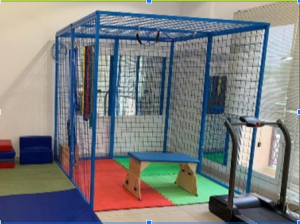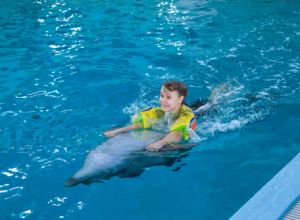
In the diverse and complex world of rehabilitation, a variety of methods exist, each designed to cater to the unique needs of patients. Intensive therapy stands out, offering focused sessions that aim to accelerate the healing process. Let’s explore this therapy’s vital role in improving lives.
Suit Therapy is a significant pillar in intensive therapy, utilizing specially designed suits equipped with rings and cords to stimulate and support various muscle groups. This approach is both innovative and tailored, ensuring each patient experiences a personalized journey towards enhanced mobility and sensory perception.
The primary allure of Suit Therapy lies in its capacity to foster improved body alignment and balance. The suits are engineered to provide consistent, gentle pressure on targeted muscles, promoting increased strength and stability which are a crucial aspect that positively impacts daily living activities.
However, every silver lining has a cloud, and Suit Therapy is no exception. One of the challenges is the initial comfort level with the suit. For some, the sensation of the rings and cords against the body requires an adjustment period. It’s a nuanced experience, and the journey to comfort can vary among individuals.

In a similar vein, the Spider Cage therapy is making strides in rehabilitation. This method involves a harness and elastic cords, set up to resemble a spider’s web. Patients are secured within this structure, allowing them to execute movements with ease and confidence. The Spider Cage proves to be a space where limitations are challenged, and new milestones are reached with each session.
One of the most commendable aspects of Spider Cage therapy is the freedom it grants to its patients. Within the confines of the web-like structure, individuals experience an enhanced range of motion, making activities that were previously difficult, now accessible. The therapy provides a supportive environment, reducing the risk of falls and injuries, ensuring safety while patients navigate through various exercises.
However, like any therapeutic approach, Spider Cage therapy comes with its set of challenges. The initial adjustment to the harness and cords can be uncomfortable for some patients. There’s a learning curve involved, where individuals must adapt to the unique setup of the Spider Cage, which can take a few sessions.
Cuevas Medek Exercises (CME) hold a special place in intensive therapy. These exercises are designed to trigger responses from the child’s muscles by providing varying levels of support. CME is a testament to the body’s natural ability to adapt and improve, fostering enhanced mobility and balance.
CME is celebrated for its capacity to awaken and stimulate inactive muscles, fostering an environment of active engagement and participation. Every exercise is a step towards amplifying muscular strength and endurance, critical factors that contribute to improved motor skills. Children practicing CME often exhibit refined coordination and control, evident in their enhanced ability to perform daily tasks with increased autonomy.
Yet, the journey with CME is not without its hurdles. One prominent challenge is the initial phase where children and their caregivers adjust to the new regimen of exercises. It’s a period of adaptation, where the distinct nature of each exercise can be both novel and challenging.

Hydrotherapy combines the therapeutic benefits of water with carefully crafted exercises. In the calming environment of water, resistance is natural and gentle, offering an ideal setting for rehabilitation. Every movement in water contributes to building strength and flexibility in a graceful manner.
Hydrotherapy stands out for its ability to offer a low-impact yet highly effective exercise environment. In the buoyant embrace of water, patients find their movements unencumbered by the full force of gravity, allowing for enhanced flexibility and range of motion.
The adaptability of hydrotherapy exercises caters to a wide array of needs. Whether it’s for the elderly seeking pain relief and increased mobility, or individuals recovering from injuries, the customized nature of hydrotherapy exercises ensures that specific needs are addressed with precision, promoting healing, and recovery.
However, hydrotherapy is not without its set of challenges. Accessibility can be a hurdle, as not all locations are equipped with the necessary facilities to offer this form of therapy. The need for specialized pools and equipment means that hydrotherapy might be a service not readily available to all.
Water quality and temperature control are essential for the safety and effectiveness of hydrotherapy. Ensuring that these parameters are consistently maintained requires meticulous attention and can influence the therapy’s overall efficacy and safety.
Physiotherapy remains a fundamental element in rehabilitation, known for creating personalized plans that address specific challenges. It combines exercises, manipulations, and equipment, each adapted to the patient’s individual journey and goals.
One of the most significant attributes of physiotherapy is its bespoke nature. Every treatment plan is a custom masterpiece, meticulously crafted to align with the patient’s unique physical needs and recovery goals. It’s a journey of transformation, where each session is a step towards enhanced mobility, reduced pain, and improved quality of life.
Physiotherapy is also renowned for its non-invasive approach. With a focus on natural movements and therapeutic exercises, it provides a safe avenue for patients to explore and enhance their physical capabilities without the risks associated with surgical or pharmacological interventions. It’s a gentle yet impactful path to healing and empowerment.
Yet, the world of physiotherapy is not devoid of challenges. The effectiveness of the treatment is often contingent on the patient’s commitment and consistency. It’s a collaboration where the patient’s active participation is as pivotal as the expertise of the therapist.
The Universal Exercise Unit, or UGUL, is a therapy that uses gravity to its advantage. With its system of pulleys and weights, UGUL is designed to target and strengthen specific muscle groups, contributing to refined muscular coordination and strength.
It offers a unique advantage of targeting individual muscle groups, ensuring focused and intensive strengthening where specific muscles are engaged and enhanced, promoting overall bodily harmony and balance.
Flexibility in adjusting the weights and resistance levels is another notable feature. This adaptability allows for a personalized approach, ensuring that patients, regardless of their fitness levels or physical limitations, can benefit from a therapy regimen tailored to their unique needs and goals.
However, UGUL’s sophistication also brings forth challenges. The apparatus, with its intricate system of pulleys and weights, requires skilled handling. The expertise of the therapist in adjusting the equipment is pivotal to ensure both the safety and effectiveness of the therapy.
Patient’s initial comfort can be another challenge. Adapting to the system and the sensations associated with the pulleys and weights can take a few sessions, necessitating patience and persistence from both the therapist and the patient.
Occupational therapy focuses on enhancing independence by improving skills needed for daily living. Each session is a stepping stone, building towards a world where challenges are transformed into opportunities for growth.
https://youtu.be/VtXlHgiA05Q
The touchstone of occupational therapy is its ability to tailor interventions to the individual’s unique needs and daily routines. It’s not a one-size-fits-all approach but a personalized journey, where therapy is interwoven into the fabric of the individual’s daily life. This integration ensures that improvements are not just measurable but also tangible in the day-to-day existence of the patient.
Furthermore, occupational therapy extends beyond physical well-being to encompass cognitive and psychological aspects. It addresses challenges in motor skills, memory, attention, and other cognitive functions, creating a comprehensive pathway to enhanced overall functionality and independence.
Nevertheless, the journey with occupational therapy also encompasses challenges. The outcomes are often gradual and require consistent effort and patience from both the patient and the therapist. It’s a process where the seeds of effort blossom over time, demanding persistence and consistency.
Speech and feeding therapy resides at the intersection where communication and nourishment converge. These specialized therapies are essential, illuminating pathways to clearer communication and more enjoyable meal times.
Speech therapy is akin to unlocking a door to a world where thoughts and feelings are expressed seamlessly. For those facing communication challenges, it cultivates an environment where sounds are not just heard but are understood, giving rise to meaningful conversations. Each session is tailored, aiming to improve articulation, language development, and communication skills, empowering individuals to express themselves confidently.
On the other hand, feeding therapy transforms meal times from a source of stress to a pleasurable experience. It’s an intricate way of addressing sensory sensitivities, enhancing motor skills, and fostering a positive association with food.
However, the journey isn’t without obstacles. Speech therapy requires consistent effort and patience. Progress can be incremental, and each milestone, no matter how small, is a product of perseverance and dedicated practice. The therapist’s skill in crafting a responsive, adaptive approach is pivotal to navigating this path effectively.
Feeding therapy too has its hurdles. It’s a sensitive journey, especially for children and their parents. Addressing and overcoming food aversions and eating challenges require a delicate balance of patience, skill, and empathy. The family’s involvement becomes crucial, turning therapy sessions into a collaborative effort where progress is collectively celebrated.
Intensive therapy showcases a variety of methods including Suit Therapy, Spider Cage, Cuevas Medek Exercises, and Hydrotherapy, each offering unique benefits tailored to individual patient needs. This diverse approach to rehabilitation highlights the progress in care techniques, making each session a step toward recovery.